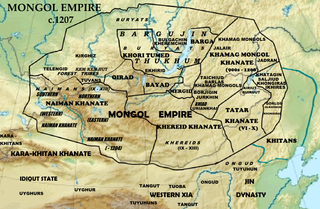Related Research Articles

Oirats or Oirds, formerly known as Eluts and Eleuths, are the westernmost group of the Mongols, whose ancestral home is in the Altai region of Siberia, Xinjiang and western Mongolia.

The Ilkhanate or Il-khanate was a Mongol khanate founded in the southwestern territories of the Mongol Empire. It was ruled by the Il-Khans or Ilkhanids, and known to the Mongols as Hülegü Ulus. The Ilkhanid realm was officially known as the Land of Iran or simply Iran. It was established after Hülegü, the son of Tolui and grandson of Genghis Khan, inherited the West Asian and Central Asian part of the Mongol Empire after his brother Möngke Khan died in 1259.
Rashīd al-Dīn Ṭabīb was a statesman, historian, and physician in Ilkhanate Iran.

A Borjigin is a member of the Mongol sub-clan that started with Bodonchar Munkhag of the Kiyat clan. Yesugei's descendants were thus said to be Kiyat-Borjigin. The senior Borjigids provided ruling princes for Mongolia and Inner Mongolia until the 20th century. The clan formed the ruling class among the Mongols and some other peoples of Central Asia and Eastern Europe. Today, the Borjigid are found in most of Mongolia, Inner Mongolia and Xinjiang, and genetic research has shown that descent from Genghis Khan and Timur is common throughout Central Asia and other regions.

The Naiman, meaning The Eight, were a medieval tribe originating in the territory of modern Western Mongolia, and are one of the 92 tribes of Uzbeks, modern Mongols and in the middle juz of the Kazakhs.

The Keraites were one of the five dominant Turco-Mongol tribal confederations (khanates) in the Altai-Sayan region during the 12th century. They had converted to the Church of the East (Nestorianism) in the early 11th century and are one of the possible sources of the European Prester John legend.

Sayyid Ajall Shams al-Din Omar al-Bukhari was Yunnan's first provincial governor, appointed by the Mongol-led Yuan dynasty of China.

Mengu-Timur or Möngke Temür was a son of Toqoqan Khan and Köchu Khatun of Oirat, the daughter of Toralchi Küregen and granddaughter of Qutuqa Beki. Mengu-Timur was a khan of the Golden Horde, a division of the Mongol Empire in 1266–1280.

The Manghud, or Manghit were a Mongol tribe of the Urud-Manghud federation. Manghuds who moved to the Desht-i Qipchaq steppe were Turkified. They established the Nogai Horde in the 14th century and the Manghit dynasty to rule the Emirate of Bukhara in 1785. They took the Islamic title of Emir instead of the title of Khan, since they were not descendants of Genghis Khan and rather based their legitimacy as rulers on Islam. However, Persian historian Rashid-al-Din Hamadani who chronicled the Mongols, claimed that many old Mongolian clans were founded by Borjigin members. The clan name was used for Mongol vanguards as well. Members of the clan live in several regions of Central Asia and Mongolia.
The Taichuud was one of the three core tribes of the Khamag Mongol confederation in the Mongolian Plateau during the 12th century, founded by Ambaghai Khan in 1148 AD, and finally ended with Sultan Husayn Tayichud in 1405 AD.

The Khongirad was one of the major divisions of the Mongol tribes. Their homeland was located in the vicinity of Lake Hulun in Inner Mongolia and Khalkha River in Mongolia, where they maintained close ties with the ruling dynasties of northern China. Because the various Hongirad clans never united under a single leader, the tribe never rose to great military glory. Their greatest fame comes from being the primary consort clan of the ruling house of Genghis Khan's Mongol empire. Genghis Khan's mother (Hoelun), great grandmother, and first wife were all Khongirads, as were many subsequent Mongol Empress and princesses.

Tuda Mengu was Khan of the Golden Horde, a division of the Mongol Empire, from 1280 until his death in 1287.

The Kharchin, or Kharachin, is a subgroup of the Mongols residing mainly in North-western Liaoning and Chifeng, Inner Mongolia. There are Khalkha-Kharchin Mongols in Dorno-Gobi Province and in Ulaanbaatar, Mongolia.
Kököchin, also Kökejin, Kūkājīn, Cocacin or Cozotine, was a 13th-century princess of the Mongol-led Chinese Yuan dynasty, belonging to the Mongol Bayaut tribe. In 1291, she was betrothed to the Ilkhanate khan Arghun by the Yuan founding emperor Kublai, but eventually was married to his son Ghazan when Arghun died by the time she arrived in Persia in 1293. The account of Kököchin's journey to Persia was given by Marco Polo, who was part of her entourage.

The Dughlat clan was a Mongol clan that served the Chagatai khans as hereditary vassal rulers of several cities in western Tarim Basin, in modern Xinjiang, from the 14th century until the 16th century. The most famous member of the clan, Mirza Muhammad Haidar, was a military adventurer, historian, and the ruler of Kashmir (1541–1551). His historical work, the Tarikh-i Rashidi, provides much of the information known about the family.
Shigi Qutuqu was a high-ranking official during the early decades of the Mongol Empire. The adopted son of the empire's founder Temüjin and his wife Börte, Shigi Qutuqu played an important role in the codification of Mongol law, serving with distinction as an administrator in North China. He may also have been a major source for the Secret History of the Mongols, which portrays him very favourably.
Jalair, also Djalair, Yyalair, Jalayir, is one of the Darliqin Mongol tribes according to Rashid-al-Din Hamadani's Jami' al-tawarikh.They lived along the Orkhon River in modern day Central Mongolia. After the Mongol conquest in the 13th century many Jalairs spread over Central Asia and the Middle East. Jalairs are one of the founding tribes of Mongolia's largest ethnic group Khalkha. People with the clan name of Jalayir are also found in Inner Mongolia in China. The Jalayirs who stayed in Central Asia under the rules of Genghis Khan's older sons' descendants eventually adopted Turkic language. They are found among the Kazakhs of the Great jüz; also they are found among the Uzbeks, Karakalpaks, and the Kyrgyz. The Jalairs who went to Iran and Iraq found the Jalairid Sultanate in 1330, and expanded into Turkey. The state was subjugated by the Kara Koyunlu in 1432.

Abu Sa'id Bahadur Khan, also spelled Abusaid Bahador Khan, Abu Sa'id Behauder, was the ninth ruler of the Ilkhanate, a division of the Mongol Empire that encompassed the present day countries of Iran, Azerbaijan, Georgia, and Armenia, as well as parts of Iraq, Turkey, Afghanistan, and Pakistan. After his death in 1335, the Ilkhanate disintegrated.
The Katagans are a medieval Mongol tribe related to Genghis Khan. In the period of Mongol conquest and assimilation with enslaved by Turkic tribes played its role in the ethnogenesis of modern Kazakhs, Kyrgyz, Karakalpaks, Uzbeks, Buryats, Uyghurs, and others.
References
- Rashid-al-Din Hamadani, Volume 1, book 1, book 2.
- Altan Tobchi
- Gumilev (1967)
- Kozin (1941)